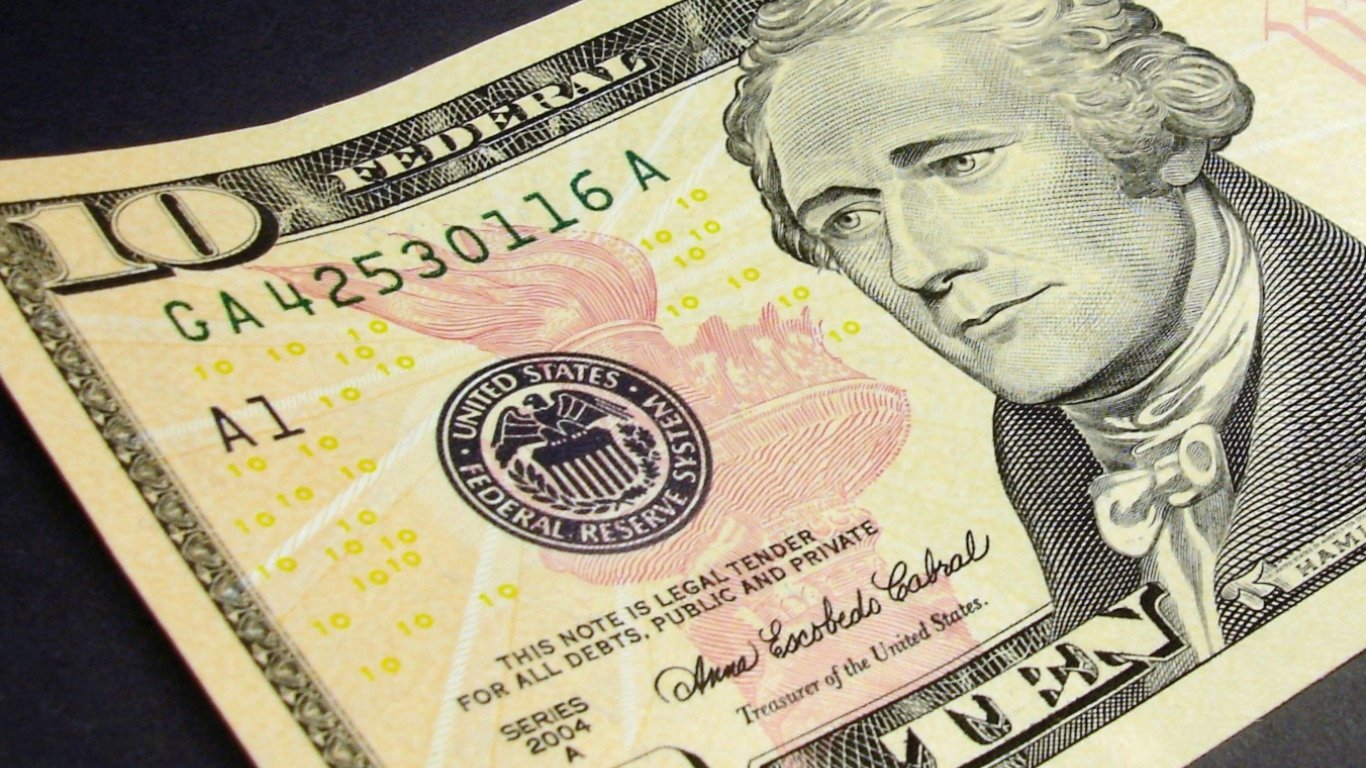

Having tariffs in a trade dispute is one thing. To impose tariffs on top of other tariffs as retaliation is quite simply a trade war. The major stock indexes were pounded lower on Friday, and this trade war is now far beyond tariffs. Tweets from President Donald Trump referred to China’s Xi Jinping as the enemy while bashing Federal Reserve Chair Jerome Powell, and there was an order for U.S. companies to look for alternatives for manufacturing in nations other than China.
China’s new tariffs on $75 billion worth of goods announced on Friday morning resulted in Friday afternoon’s announcement by President Trump that the United States will now raise its duties to 30% from 25% on $250 billion worth Chinese goods, and the remaining $300 billion will see their tariffs raised to 15% from 10%.
China is obviously willing to take the pain here in this trade war, and its historic efforts would indicate that the nation will want to “save face” in its international dealings as any part of a larger agreement. The larger issue, one the United States cannot avoid, is that President Xi Jinping does not have to answer to the Chinese population via elections or by sentiment. China also has been able to dictate how much pain or prosperity its massive population has to deal with, again without recourse. And if China wants to tell millions of its factory workers that they have to become farmers there may not be much that will be done about it.
Friday’s drop of 623 points on the Dow Jones industrial average and almost 76 points on the S&P 500 amounted to losses of almost 2.4% and almost 2.6%, respectively. The technology-heavy Nasdaq, which is actually in the strike zone of the intellectual property issues and forced technology transfers in the trade war, fell over 239 points, or 3% on Friday.
24/7 Wall St. witnessed many U.S. technology stocks taking it right on the chin in Friday’s trading, and ditto for the top stocks that would be considered the direct comparable companies to the Chinese firms mentioned. Where further weakness also was seen was in the American depositary shares (ADSs) of many of China’s top stocks actively traded in the United States. Ditto for the exchange-traded funds (ETFs) that track China’s exchanges.
China already has proven that it doesn’t care about a debt downgrade and that it is willing to let its yuan currency fall further, and the nation has increased pressure on capital control by limiting the amount of capital that its citizens can invest outside of the country. In short, Xi and the rest of the leaders can stomach endless economic pain as far as they are concerned. President Trump has used the success of the stock market and the strong economy since winning the presidential election in November of 2016. The major U.S. equity indexes just hit all-time highs in July of 2019, and they are all still up double-digit percentages year to date.
Here is a look at how the top Chinese companies and their perceived U.S. counterparts, as well as the biggest exchange-traded and closed-end funds that track the People’s Republic of China, traded on Friday. We also looked at the share reactions in the after-hours (if available) session for the Chinese stocks after Trump’s retaliation after the market closed.
Tech and reselling in China and Asia: Alibaba Group Holding Ltd. (NYSE: BABA) was trading down 4.3% at $164.54 on Friday, and the $428 billion market cap is down 16% from its 52-week high. Alibaba is the largest e-commerce company in China. Its shares had peaked at close to $205 at the start of 2018, so the drop is even worse than over the past 52 weeks since its high in that period is $195.72. Alibaba was down 1.1% to $162.70 in Friday’s after-hours reaction. JD.com Inc. (NASDAQ: JD) was down 2.4% to $28.77 with a market cap of almost $42 billion on Friday. While it is down 13% from its 52-week high, this was a $49 stock at the start of 2018. JD.com shares were down an additional 0.8% at $28.54 in Friday’s after-hours trading session. Amazon.com Inc. (NASDAQ: AMZN) was down 3.1% at $1,749.62 on Friday, and it is now down about 15% from its 52-week and all-time high.
Search and development in China: Baidu Inc. (NASDAQ: BIDU) fell 3.4% to $101.85, down about 56% from its 52-week high. This company is more or less the premier search engine in China, along with many sidebar projects and revenues similar to that of Google/Alphabet. Its market cap is now down to just $35 billion. Baidu shares were down an additional 0.7% to $101.12 in Friday’s after-hours trading. Alphabet Inc. (NASDAQ: GOOGL) was down 3.2% at $1,153.58 on Friday, and its shares are now down 11% from its 52-week and all-time high.
Social media: Momo Inc. (NASDAQ: MOMO) shares were down about 3.2% at $31.83 on Friday, and it is down about 34.5% from its 52-week high. The company operates one of the larger social networking sites in the People’s Republic and has a market cap of nearly $6.5 billion. Facebook Inc. (NASDAQ: FB) was down over 2.3% at $177.75 on Friday, and that was down about 15% from its 52-week high.
Gambling in Macau: These shares also tanked, with U.S.-listed shares doing worse. Melco Resorts & Entertainment Ltd. (NASDAQ: MLCO) was down 3.6% at $19.67 on Friday with a $1.15 billion market cap. That is down about 27% from its 52-week high. Wynn Resorts Ltd. (NASDAQ: WYNN) saw its shares fall over 4.3% to $105.33, down about 30% from its 52-week high and down almost 50% from the start of 2018. Las Vegas Sands Corp. (NYSE: LVS) was down 2.4% at $53.11, down 24% from its 52-week high and down about 34% from its high at the start of 2018.
Restaurants in China: Yum China Holdings Inc. (NYSE: YUMC), the local operator of KFC, Pizza Hut and Taco Bell that is now (mostly) free of Yum! Brands itself, was down 3.5% at $42.57 on Friday. That is down 12% from its 52-week high. Yum! Brands Inc. (NYSE: YUM) was down 1.7% at $115.31 on Friday, but it is down only about 3% from its 52-week high.
Coffee in China: Luckin Coffee Inc. (NASDAQ: LK) is sometimes referred to as the “Starbucks of China.” Luckin was down 2.1% at $18.79 on Friday, and the shares were down another 0.9% at $18.62 in Friday’s after-hours session. This is now down 30% from its post-IPO peak, but comparing peaks after an IPO is sometimes an apples-to-oranges proposition. Starbucks Corp. (NASDAQ: SBUX) was down 1.86% at $94.70 on Friday, but this is down only 5% from its recent all-time high.
Telecom and wireless in China: China Mobile Ltd. (NYSE: CHL) is one of the largest mobile telecom service providers in China, but a 0.9% drop to $41.65 on Friday has taken its market cap down to $171 billion. The stock is now down over 25% from its 52-week high. China Mobile was a $71 ADS back in 2015. China Unicom (Hong Kong) Ltd. (NYSE: CHU) was down 1.1% at $9.93 on Friday. This company is another of the major telecom companies in China and is now down over 25% from its 52-week high with a $30 billion market cap. This was nearly a $19 stock at one point in 2015. AT&T Inc. (NYSE: T) was down 1.6% at $34.82, and Verizon Communications Inc. (NYSE: VZ) was down 1.5% at $55.92 on Friday.
Life insurance in China: China Life Insurance Co. Ltd. (NYSE: LFC) saw its ADSs fall 0.7% to $11.49 on Friday, with a market cap that is still $101 billion. Its shares are down about 21% from its 52-week high. American International Group Inc. (NYSE: AIG) was down 2.3% at $52.59, with a $45.6 billion market cap on Friday, and MetLife Inc. (NYSE: MET) was down 3.5% at $44.59, with a $42.1 billion market cap.
Oil and gas giants: China Petroleum & Chemical Corp. (NYSE: SNP) was down 1.5% at $58.02, with an $81 billion market cap on Friday. That is down about 43% from its 52-week high. CNOOC Ltd. (NYSE: CEO), another top energy stock, was down 2.9% at $141.46 on Friday, with a $63 billion market cap. CNOOC was last seen trading down just over 30% from its 52-week high. Exxon Mobil Corp. (NYSE: XOM) was down 3% at $67.49 on Friday, and that is now down over 27% from its 52-week high.
Friday’s key moves in the top ETFs and closed-end funds that track China were shown as follows:
- iShares China Large-Cap (NYSEARCA: FXI) is the top ETF tracking China, and it was down 1.8% at $38.43 on Friday, down 16.6% from its 52-week high.
- Deutsche X-Trackers Harvest CSI300 CHN A (NYSEARCA: ASHR) traded down about 1.9% to $26.67 on Friday, and it is down about 13.5% from its 52-week high.
- iShares MSCI Hong Kong (NYSEARCA: EWH) was down 1.7% to $23.06 on Friday, and it is down 15% from its 52-week high.
- SPDR S&P China ETF (NYSEARCA: GXC) was down 2.3% at $88.03 on Friday, and that is down 16% from its 52-week high.
- The China Fund Inc. (NYSE: CHN) was down 1.6% at $19.21 on Friday, and that is down about 11.2% from its 52-week high.
- Morgan Stanley China A Share Fund Inc. (NYSE: CAF) was down almost 1.8% to $20.81 on Friday, and that is a drop of over 15% from its 52-week high.
Unfortunately, this trade war is a double-edged sword that will not come without some pain to the consumer and the economy in the United States. China may be far worse off in the trade war than the United States. Friday’s reaction in many top U.S. companies, particularly those with large revenues from China, was rather brutal on the American side of the equation.
Within some degree of reason, China doesn’t have to care what happens in its economy, nor whether politicians can be thrown out of office every four, six and eight years. China is also known for thinking decades ahead, or even a century. The United States doesn’t have that luxury.
Sponsored: Attention Savvy Investors: Speak to 3 Financial Experts – FREE
Ever wanted an extra set of eyes on an investment you’re considering? Now you can speak with up to 3 financial experts in your area for FREE. By simply
clicking here you can begin to match with financial professionals who can help guide you through the financial decisions you’re making. And the best part? The first conversation with them is free.
Click here to match with up to 3 financial pros who would be excited to help you make financial decisions.
Thank you for reading! Have some feedback for us?
Contact the 24/7 Wall St. editorial team.
 24/7 Wall St.
24/7 Wall St.


